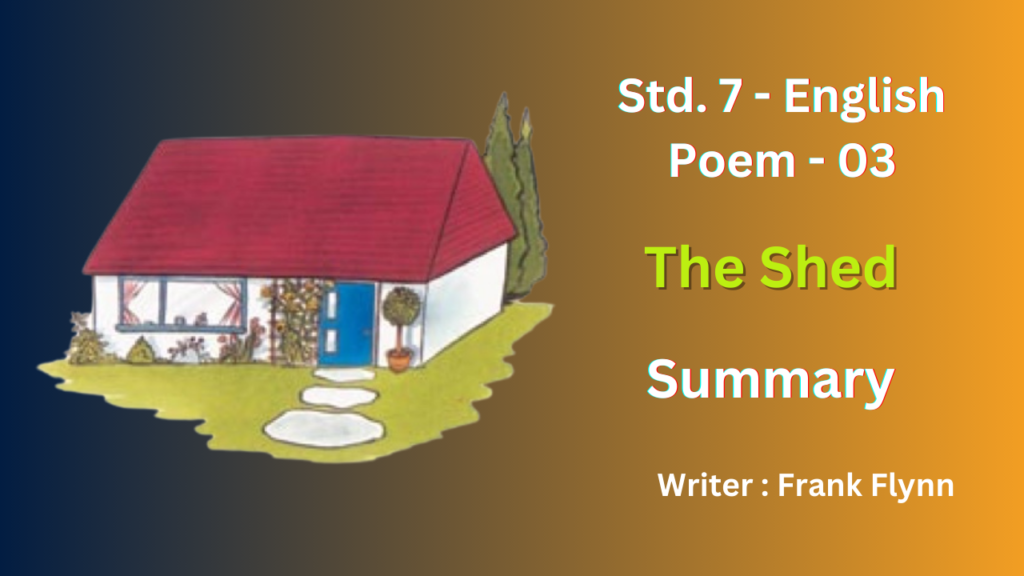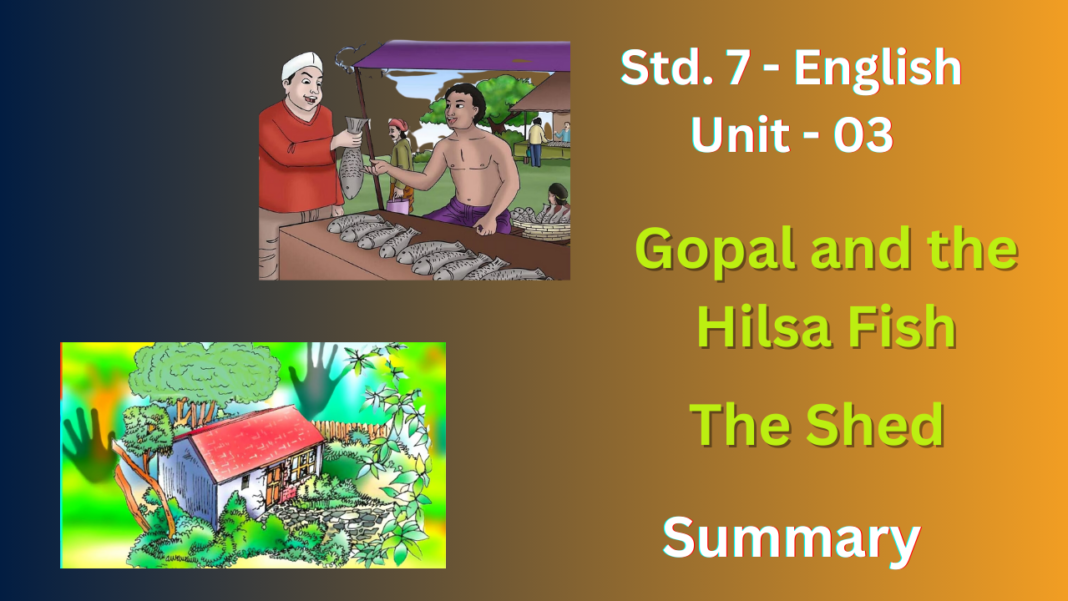NCERT Solutions for Class 7 English Chapter 3
Gopal and the Hilsa Fish
In the chapter “Gopal and the Hilsa Fish,” the king is obsessed with Hilsa fish, the talk of the town during that season. Everyone, from sellers to courtiers, is discussing this prized catch. This constant chatter annoys the king to the point of frustration.
He challenges Gopal, his wise and witty courtier, to bring a Hilsa fish to the palace without anyone asking him about it. Gopal accepts the challenge.
Here’s how Gopal cleverly completes the task:
- Disguise: Gopal doesn’t show up at the palace looking his usual dignified self. He half-shaves his face, applies ashes, and wears torn clothes, making him look like a madman.
- Silent Walk: People on the street stare at his bizarre appearance and laugh, but none of them ask about the Hilsa fish he carries.
- Confusion at the Palace: The guards are hesitant to let this strange-looking man enter the palace. However, upon learning his identity, they take him before the king.
- Challenge Met: When the king questions his attire, Gopal reminds him of the challenge and proudly reveals the Hilsa fish. No one had asked him about it during his entire journey!
- King’s Amusement: The king bursts into laughter, impressed by Gopal’s cleverness and his ability to complete the seemingly impossible task.
This story highlights Gopal’s wit and resourcefulness. It also emphasizes the importance of thinking creatively to solve problems in unconventional ways.

Working With Text
Answer the following
1. Why did the king want no more talk about the Hilsa fish?
Ans : The king didn’t want any more talk about the Hilsa fish because he was incredibly annoyed by it. The story describes the Hilsa fish being the talk of the town during that season, with everyone constantly discussing it. This constant chatter, likely for days or even weeks, frustrated the king to the point where he couldn’t tolerate it anymore.
2. What did the king ask Gopal to do to prove that he was clever?
Ans : The king, frustrated by the constant talk about Hilsa fish, challenged Gopal to prove his cleverness by bringing a Hilsa fish to the palace under one specific condition: without anyone asking him about the fish. This seemingly impossible task forced Gopal to think outside the box and use his wit to complete it successfully.
3. What three things did Gopal do before he went to buy his Hilsa fish?
Ans : Gopal did three things to disguise himself before he went to buy the Hilsa fish:
- Half-shaved his face: This created an unkempt and unusual appearance.
- Applied ashes: Smearing ashes on his body further contributed to his disheveled look.
- Wore torn clothes: His ragged attire completed the image of a madman, making people less likely to take him seriously or engage him in conversation.
4. How did Gopal get inside the palace to see the king after he had bought the fish?
Ans : Gopal’s disguise made getting into the palace a bit tricky. The story mentions two key points:
- Hesitant Guards: When Gopal, looking like a madman, arrived at the palace, the guards were naturally hesitant to let him in. They likely questioned his presence and purpose at the royal court.
- Identity Revealed: However, upon learning his identity (either Gopal revealed himself or someone recognized him), the guards couldn’t ignore a royal courtier. They probably understood the urgency of his situation and the king’s challenge.
5. Explain why no one seemed to be interested in talking about the Hilsa fish which Gopal had bought.
Ans : Gopal’s crazy get-up – half-shaved face, ashes, and torn clothes – made him such a spectacle that everyone was too focused on his bizarre appearance to even notice the Hilsa fish. They were weirded out and more interested in him than the fish itself.
6. Write True or False against each of the following sentences.
- The king lost his temper easily
- Gopal was a madman
- Gopal was a clever man
- Gopal was too poor to afford decent clothes
- The king got angry when he was shown to be wrong
Ans :
- False
- False
- True
- False
- False
Working With Language
Notice how in a comic book, there are no speech marks when characters talk. Instead what they say is put in a speech ‘bubble’. However, if we wish to repeat or report what they say, we must put it into reported speech.
Change the following sentences in the story to reported speech. The first one has been done for you.
- How much did you pay for that Hilsa?
The woman asked the man how much did he pay for that Hilsa.
- Why is your face half-shaven?
Gopal’s wife asked him………………. - I accept the challenge, Your Majesty.
Gopal told the king ……………….. - I want to see the king.
Gopal told the guards …………………. - Bring the man to me at once.
The king ordered the guard ………………….
Ans :
- Gopal’s wife asked him why his face was half-shaven.
- Gopal told the king that he accepted the challenge.
- Gopal told the guards that he wanted to see the king.
- The king ordered the guard to bring the man to him at once.
2. Find out the meaning of the following words by looking them up in dictionary. Then use them in sentences of your own.
Challenge , mystic , comical , courtier , smearing
Ans : Challenge: (noun) a difficult task that tests someone’s abilities; (verb) to dare someone to do something.
- Sentence (noun): Learning a new language is a challenge, but it’s also very rewarding.
- Sentence (verb): My friend challenged me to a race up the hill.
- Mystic: (noun) a person who seeks to understand mysteries or achieve spiritual enlightenment through contemplation or asceticism. (adjective) mysterious or having a connection with the supernatural.
- Sentence (noun): The mystic spent years meditating in a remote cave.
- Sentence (adjective): The fog created a mystic atmosphere around the old abandoned house.
- Comical: (adjective) funny or amusing.
- Sentence: The clown’s comical antics made everyone laugh.
- Courtier: (noun) a person who attends a royal court.
- Sentence: The wise courtier offered valuable advice to the king.
- Smearing: (verb) to spread a sticky substance over something in a messy way.
- Sentence: The child was smearing mud all over their clothes while playing in the garden.
Picture Reading :
- Now ask your partner questions about each picture.
(a) Where is the stag?
(b) What is he doing?
(c) Does he like his antlers (horns)?
(d) Does he like his legs?
(e) Why is the stag running?
(f) Is he able to hide in the bushes?
(g) Where are the hunters now?
(h) Are they closing in on the stag?
(i) Is the stag free?
(j) What does the stag say about his horns and his legs?
Ans :
(a) The stag stands gracefully by the side of a still pond.
(b) He lowers his head to drink from the cool water, catching a glimpse of his reflection.
(c) Yes, he admires the majesty of his antlers, a symbol of strength and maturity.
(d) However, he’s not entirely content. He considers his legs to be a bit thin compared to his impressive antlers.
(e) Suddenly, the stag freezes. He spots a group of hunters approaching in the distance.
(f) Knowing his antlers might get tangled in the bushes, he takes an alternative route, relying on his agile legs.
(g) The hunters, on the other hand, are close behind, following the trail the stag left behind.
(h) They gain ground as the thick forest makes it difficult for the stag to maneuver his antlers.
(i) Just in time, a dense thicket appears. The stag dives in, his slim legs allowing him to squeeze through. The hunters arrive moments later, frustrated to find their quarry vanished.
(j) The stag emerges, panting but safe. He realizes that his once-disliked legs, which he considered ungainly, were his true saviors. His antlers, a source of pride, almost led to his capture. This experience teaches him that true strength lies not just in appearance but also in adaptability and resourcefulness.
2.Now write the story in your own words. Give it a title.
Ans :
A Lesson in the Reeds
The stag, a magnificent creature with a crown of antlers, stood beside a tranquil pond. He dipped his head to drink, and the still water mirrored back his image. Pride swelled in his chest as he admired his antlers, a symbol of power and dominance. But a flicker of discontent crossed his features – his legs seemed slender and insignificant compared to his glorious headgear.
Suddenly, a rustle in the bushes sent shivers down his spine. Hunters! Without hesitation, the stag bolted, his powerful legs propelling him forward. He knew his antlers could snag on branches, becoming a deadly trap. Veering away from the dense forest, he relied on his agility to weave through open clearings.
The pounding of hooves grew closer. Glancing back, the stag saw the hunters in hot pursuit, their path easier through the sparse trees. Desperation surged through him. Just ahead, a thicket of tall reeds offered a glimmer of hope. He plunged into the dense growth, his slender legs allowing him to vanish into the green maze.
Moments later, the frustrated hunters emerged, their prey mysteriously gone. The stag, hidden within the reeds, let out a soft sigh of relief. He had escaped, not because of his majestic antlers, but because of the legs he once considered a flaw.
Emerging from his refuge, the stag stood tall, no longer prideful about his antlers. He had learned a valuable lesson. True strength wasn’t just about outward appearance, but about resourcefulness and the ability to adapt. From that day on, he carried his head high, not just for his impressive antlers, but also for the nimble legs that had saved his life.
The Shed
The poem “The Shed” by Frank Flynn explores a child’s curiosity and apprehension towards an old, unused shed at the back of their garden. Here’s a summary:
Setting and Description:
- The speaker describes an old shed at the bottom of their garden.
- Details like a spider web on the door, rusty hinges, and dusty windows create an image of a neglected and potentially mysterious place.
The Child’s Feelings:
- The speaker feels a sense of curiosity and fascination with the shed.
- They imagine someone living inside and sometimes feel like they are being watched from the dusty window.
- However, the speaker also expresses fear of what might be inside, with creaking noises and a mention of a ghost story told by their brother.
Internal Conflict and Resolution:
- The poem reflects the child’s internal conflict between wanting to explore the shed and their fear of the unknown.
- They convince themselves that there’s nothing to be afraid of, the spider web is old, and the ghost story isn’t real.
- The poem ends by hinting that the child might finally overcome their fear and enter the shed someday.
Themes:
- The poem explores childhood curiosity and the fear of the unknown.
- It also touches upon the power of imagination and the way it can create both wonder and apprehension.
Uncertainties:
- The poem doesn’t explicitly reveal the contents of the shed or confirm if it’s haunted. This ambiguity allows readers to use their own imagination.
- Whether the child actually enters the shed remains unresolved, leaving the story open-ended.

1. Answer the following questions.
1. Who is the speaker in the poem?
Ans : The speaker in the poem “The Shed” is a child.
2. Is she/he afraid or curious or both?
Ans : The speaker in “The Shed” is both afraid and curious.
- They feel a strong pull towards exploring the shed, imagining someone living inside and experiencing a sense of wonder.
- However, the creaking noises, dusty windows, and ghost story fuel their fear of the unknown.
3. What is she/he planning to do soon?
Ans : The poem “The Shed” leaves the ending open-ended, but it hints that the child might overcome their fear and enter the shed soon. We can’t say for sure though, as the poem concludes before revealing any concrete action.
4. “But not just yet…” suggests doubt, fear, hesitation, laziness or something else. Choose the word which seems right to you. Tell others why you chose it.
Ans : I choose hesitation. “Not just yet” suggests a delay, not a dismissal. The speaker might be willing, but not quite ready.
2. Is there a room in your house or a house in your neighbourhood/locality where you would rather not go alone, and never at night? If there is such a place and a story to go with it, let others hear all about it.
Ans : Our house has a creepy storeroom tucked away in the backyard, far from the main building. It’s crammed with forgotten things, and the single dusty bulb barely cuts through the gloom. Just stepping inside feels like entering a forgotten world.
One night, my mom, bless her soul, sent me on a daring mission – retrieve something from the storeroom. My heart hammered in my chest as I approached the creaky door. Every shadow seemed to writhe and dance in the dim light, my imagination running wild. Finally, with a deep breath, I flung open the door and… screamed like a banshee.
Turns out, the menacing shadows were just figments of my overactive imagination, a result of the eerie atmosphere. Still, that doesn’t stop me from getting a shiver down my spine every time I walk past that storeroom door at night.
FAQ’s
What are the key stories covered in NCERT Class 7 English Chapter 3?
Chapter 3 of Class 7 English includes “Gopal and the Hilsa Fish” and “The Shed,” two captivating narratives.
Can you provide a brief overview of “Gopal and the Hilsa Fish”?
“Gopal and the Hilsa Fish” narrates the tale of Gopal’s cleverness and determination in catching a prized fish, showcasing themes of perseverance and resourcefulness.
What is the significance of “The Shed” in this chapter?
“The Shed” is a story that explores the bond between siblings and the importance of empathy and understanding in relationships, highlighting themes of compassion and familial love.
How do NCERT Solutions for Class 7 English Chapter 3 aid in understanding these stories?
These solutions offer comprehensive analyses and explanations of the texts, helping students grasp the themes, characters, and literary devices employed in “Gopal and the Hilsa Fish” and “The Shed.”
Why are “Gopal and the Hilsa Fish” and “The Shed” important for students?
These stories provide valuable life lessons and insights into human experiences, fostering empathy, critical thinking, and appreciation for cultural diversity among students.









